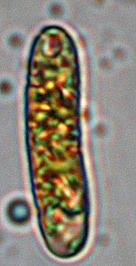| Cell | Chlorophyll | Pigments | Membranes | Thylakoids | Storage | Covering | Flagella |
|---|---|---|---|---|---|---|---|
| Prokaryotic | a | Phycocyanin, Allophycocyanin | No chloroplast | No chloroplast | starch, granules, polyhedral bodies | murein and polysaccharides | None |

| Public Domain | Public Domain | Wikimedia Commons. Anabaena_sperica.jpeg |
Cyanobacteria, or blue-green algae, are a group of prokaryotic, photosynthetic organisms.
Cyanobacteria are considered a primitive form of life because were an early, and likely the earliest, form of life on earth. The cells of blue-green algae are called prokaryotic cells (from Greek “pro” for “before” and “karyon” referring to the “nut” or nucleus). The cells are small, and require a microscope to observe their structures. Individual cells, however, may form colonies that are visible to the naked eye.
Cyanobacteria are photosynthetic, that is, they use energy from the sun (photosynthesis) to make sugars inside the cell. They were not only the earliest organisms on earth, they are responsible for changing the composition of the atmosphere. When cyanobacteria evolved a couple of billion years ago, there was no oxygen in the atmosphere. Gradually, over time, the oxygen released through photosynthesis created the atmosphere that we have today. These tiny organisms also affect the global cycle of nitrogen. Cyanobacteria are one of a small group of organisms, which are able to “fix” nitrogen and are very important in the global nitrogen cycle. They fix 28 teragrams or 6.17 x 1010 pounds (equal to almost 7 million elephants) of nitrogen per year just in the ocean. There are other nitrogen fixers in freshwaters, as well. As compared to the other algal divisions, many of the cyanobacteria are able to live in extreme environments. For example, some species of cyanobacteria are able to live in hot springs, where temperatures reach to 72°C (176°F). They also live in hypersaline (high salt concentrations) habitats of marine tidal areas.
Structure
Cells range in size from less than 1 micron to about 40 microns. Note that a micron is 0.001 meters. For comparison, the human hair is about 90 microns in width. Unlike the eukaryotic algae, with a membrane-bound nucleus, the cyanobacteria lack a membrane around the cell nucleus. Cyanobacteria are found in a large variety of forms, or with a range of morphologic features. Cells may grow alone (unicellular) and or in colonies (such as filaments, spherical balls, branching filaments, and sheets of cells). Five morphological groups have been established, shown in Table 1. Some species of cyanobacteria have specialized cells, called heterocysts, that absorb nitrogen from the atmosphere (as N2) and convert it to ammonia, which can be used by other organisms.
Cyanobacteria groups:
I. Unicellular: single cells or cell aggregates. Gloeothece, Gloeobacter, Synechococcus, Cyanothece, Gloeocapsa, Synechocystis, Chamaesiphon, Merismopedia
II. Pleurocapsalean: reproduce by formation of small spherical cells called baeocytes produced through multiple fission. Dermocarpa, Xenococcus, Dermocarpella, Pleurocapsa, Myxosarcina, Chroococcidiopsis
III. Oscillatorian: filamentous cells that divide by binary fission in a single plane. Oscillatoria, Spirulina, Arthrospira, Lyngbya, Microcoleus, Pseudanabaena
IV. Nostocalean: filamentous cells that produce heterocysts Anabaena, Nostoc, Calothrix, Nodularia, Cylinodrosperum, Scytonema
V. Branching: cells divide to form branches Fischerella, Stignoema, Chlorogloeopsis, Hapalosiphon
Blue-green algae in Rocky Mountain Lakes
In the Rocky Mountains, cyanobacteria live in nearly every type of environment that contains even a small amount of water – cyanobacteria are found in lakes, streams, soil, even growing within small spaces on the surfaces of rocks. In montane and alpine lakes, a number of genera, such as Aphanothece and Chroococcus grow in the plankton (from Greek for “wanderer” or “drifter”). The phytoplankton are those organisms that photosynthesize and are carried by currents in the water; they are not able to move on their own. Genera such as Nostoc are able to fix nitrogen by forming heterocysts. Genera such as Lyngbya and Oscillatoria form filaments that grow on the bottom of lakes, or may be carried by water currents in the plankton.
44 taxa shown below, 39 of which appear in at least one sample.
Region:
RMNP = Rocky Mountain National Park, CO
SLW = Silver Lakes Watershed, CO
Images are not scaled. An individual that looks bigger than its neighbors might actually be smaller. All images were made to fit within an area of 360px high and 200px wide.
 Cyanophyte sp. Length <1-1 µm Width <1-1 µm |
 Rhabdoderma sp. Length 1.5-2.5 µm Width 0.5-1.0 µm |
Representative images missing for: Anabaena sp. | Anabaena spiroides | Aphanocapsa delicatissima | Aphanotheca sp. | Aphanothece clathrata | Aphanothece minutissima | Aphanothece sp. | Chroococcus dispersus | Chroococcus limneticus | Chroococcus sp. | Chroococcus turgidus | Chroococcus varius | Dactylococcopsis acicularis | Dactylococcopsis fasciculatus | Dactylococcopsis sp. | Gloeothece sp. | Lyngbya (Leptolygnbya) nana | Lyngbya limnetica | Lyngbya nana | Lyngbya sp. | Merismopedia sp. | Microcystis sp. | Nostoc paludosum | Nostoc sp. | Oscillatoria augusta | Oscillatoria augustissima | Oscillatoria limnetica | Oscillatoria sp. | Oscillatoria sp. 1 | Oscillatoria sp. 2 | Oscillatoria subbrevis f. minor | Phormidium sp. | Planktolygnbya subtilis (Lyngbya limnetica) | Rhabdoderma sigmoidea | small blue-green filament | Symplocastrum sp. | Synechococcus elongatus | Synechococcus irregulare | Synechococcus linearis | Synechococcus sp. | Synechocystis sp. | Tetrarcus ilsteri |

